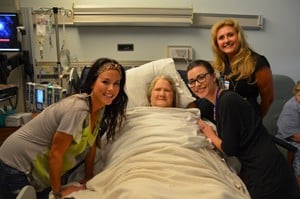Makeovers Uplift Cancer Patients in UAMS Hospital
| “I’ve never had a makeover before,” said Marcia Sweatt, as a specially trained cosmetologist applied blush to her cheeks. “This was such a surprise.”

Cosmetologist Lindsey Mears applies mascara to patient Marcia Sweatt during Look Good Feel Better makeover.
A patient for more than two weeks in the cancer wing at the University of Arkansas for Medical Sciences (UAMS) hospital, Sweatt was excited to find out she could get a makeover without leaving her bed.
“It shocked me, but it made me feel good. I really appreciate it,” said Sweatt, who is in treatment for Burkitt’s lymphoma.
The makeover came courtesy of Look Good Feel Better, a program of the American Cancer Society that is offered free of charge to cancer patients throughout the United States. While outpatients at the UAMS Winthrop P. Rockefeller Cancer Institute have benefited from the program since 2003, the inpatient extension of the program has only been in place since February 2014. It is the only Look Good Feel Better program for hospital inpatients in the ACS’ six-state Mid-South Region.
Led by specially trained cosmetologists, Look Good Feel Better teaches beauty techniques to women in active cancer treatment to help them combat the appearance-related side effects of cancer treatment. Participants learn ways to cope with hair loss through the use of wigs, scarves and other accessories. They also are taught skin care, makeup and nail care tips, and each participant receives a free cosmetics kit donated by the cosmetics industry.

Patient Marcia Sweatt following her makeover with cosmetologists (from left) Megan Harrell and Lindsey Mears and UAMS Medical Center Auxiliary President Lisa Yarnell.
“We can thank our volunteer Lisa Yarnell for developing this idea and bringing it to reality for our patients,” said Erin Gray, director of the UAMS Medical Center Volunteer Services and Auxiliary. Yarnell serves as 2014 president of the UAMS Medical Center Auxiliary and is an eight-year cancer survivor.
A long-time volunteer at UAMS and other organizations, Yarnell had previously worked with the Look Good Feel Better program and seen its positive impact on women experiencing appearance-related changes due to cancer treatment. She contacted the local chapter of the American Cancer Society to determine if an inpatient program were possible and then set about ensuring that all requirements were met, including locating cosmetologists willing to receive extra training and commit to the monthly sessions.
“Dedicated cosmetologists are the key to making this happen. They volunteer their time and keep this program going for our patients,” said Yarnell, who also attends each of the monthly sessions to meet the patients, share her experience as a cancer survivor and offer support.
With four cosmetologists committed to the inpatient program, some sessions have seen as many as eight women receive makeovers on the same day. And due to the lengthy stays that some patients experience, Yarnell, Gray and the cosmetologists are able to check in on the women in the weeks following their makeovers, offering an extra level of support.
“We are so happy to offer this to our patients,” said Gray. “It gives them something to look forward to and changes their whole demeanor.”